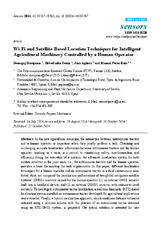Wi-Fi and Satellite-Based Location Techniques for Intelligent Agricultural Machinery Controlled by a Human Operator
Autor
Drenjanac, Domagoj
Tomic, Slobodanka
Pérez Ruiz, Manuel
Agüera Vega, Juan
Editor
MDPIFecha
2014Materia
DGNSSAutonomous vehicle
RTK-GNSS
Trilateration
METS:
Mostrar el registro METSPREMIS:
Mostrar el registro PREMISMetadatos
Mostrar el registro completo del ítemResumen
In the new agricultural scenarios, the interaction between autonomous tractors
and a human operator is important when they jointly perform a task. Obtaining and
exchanging accurate localization information between autonomous tractors and the human
operator, working as a team, is a critical to maintaining safety, synchronization, and
efficiency during the execution of a mission. An advanced localization system for both
entities involved in the joint work, i.e., the autonomous tractors and the human operator,
provides a basis for meeting the task requirements. In this paper, different localization
techniques for a human operator and an autonomous tractor in a field environment were
tested. First, we compared the localization performances of two global navigation satellite
systems’ (GNSS) receivers carried by the human operator: (1) an internal GNSS receiver
built into a handheld device; and (2) an external DGNSS receiver with centimeter-level
accuracy. To investigate autonomous tractor localization, a real-time kinematic (RTK)-based
localization system installed on autonomous tractor developed for agricultural applications
was evaluated. Finally, a hybrid localization approach, which combines distance estimates
obtained using a wireless scheme with the position of an autonomous tractor obtained
using an RTK-GNSS system, is proposed. The hybrid solution is intended for user localization in unstructured environments in which the GNSS signal is obstructed. The
hybrid localization approach has two components: (1) a localization algorithm based on the
received signal strength indication (RSSI) from the wireless environment; and (2) the
acquisition of the tractor RTK coordinates when the human operator is near the tractor. In
five RSSI tests, the best result achieved was an average localization error of 4 m. In tests of
real-time position correction between rows, RMS error of 2.4 cm demonstrated that the
passes were straight, as was desired for the autonomous tractor. From these preliminary
results, future work will address the use of autonomous tractor localization in the hybrid
localization approach.

